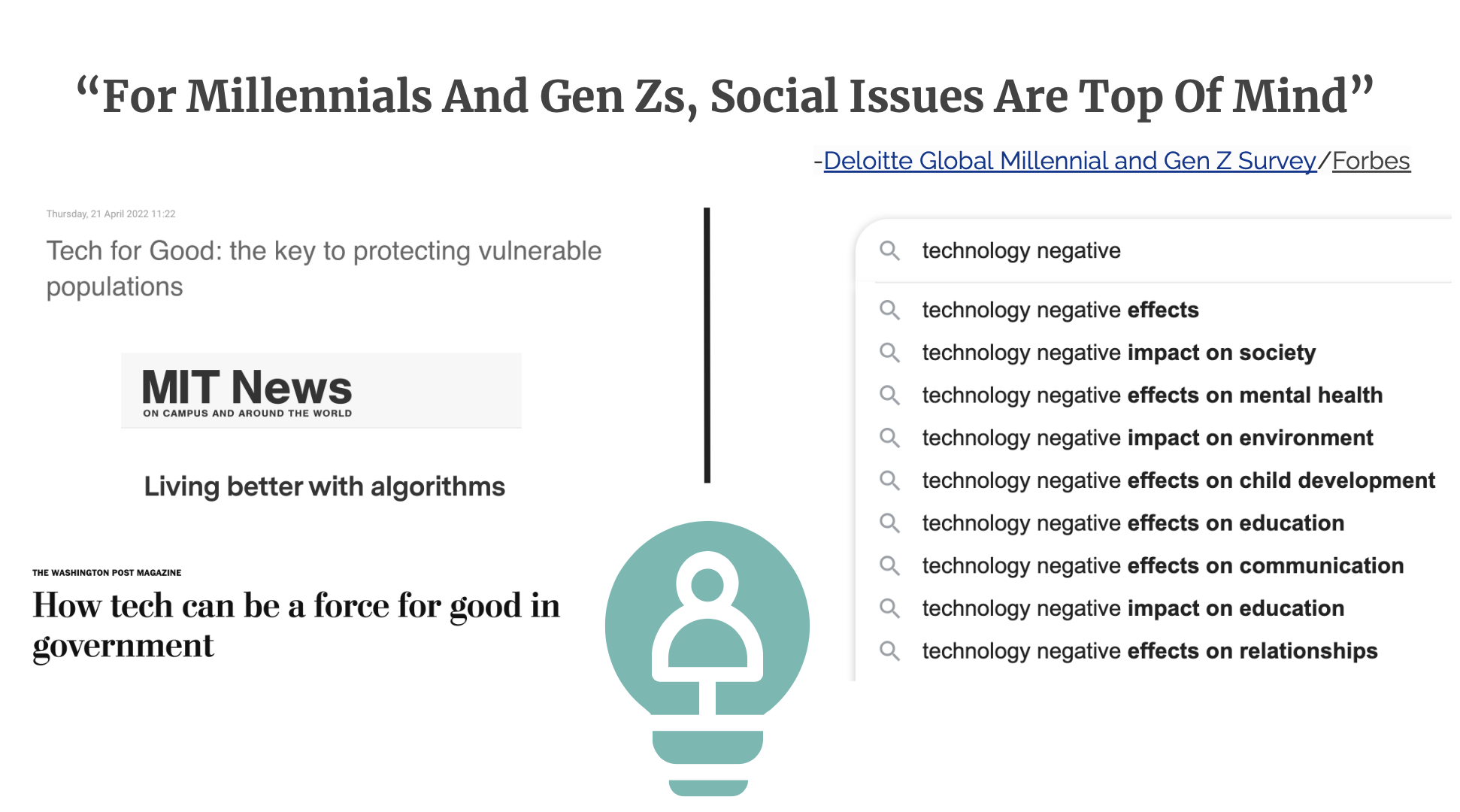
The Future of Social Responsibility: Diverse User Perspectives
While there is a high demand for tech for good initiatives, research shows that there is a great sense of disillusionment or loss of trust in the tech industry because of evidence that technology has created harms for society
Amongst society’s disillusionment in the tech sphere:
How can tech companies better understand everyday people’s views of social issues and how they ascribe responsibility in order to effectively innovate in the social responsibility space?
The Problem
Background
Client: Google Area 120
What is the situation?
We worked with UX Researchers from Area 120 as part of our User Experience Research course. Area 120 is Google’s “in-house” incubator where many ideas are born.
As this incubator matures, they are concerned about how to proactively include social responsibility, while having a future thinking approach
Client’s Objectives
1) What are the values that A120 and other tech companies can and should assume?
2) What are the frameworks for the role of tech in social responsibility?
3) What startups should be invested in and advised?
The Research
Goal: To better understand the role that participants envision tech to play in social issues in the future
R1: How do participants prioritize social issues?
R2: How do participants ascribe responsibility for social issues?
R3: What do participants envision the role of tech companies to be in addressing social issues?
Closed Card Sorting
11 Interviews
The Research
2 Focus Groups
Why Interviews?
To understand the way people think about social issues
In-depth individual exploration
Early Discovery / Generative
Not what people said (i.e. social issue), but why they said it (i.e. how did they decide on that social issue)
Why Focus Groups?
Peer participation + building on each other’s responses - future thinking can be difficult to conceptualize alone
Makes future thinking easier: baseline vs. transformation
Incorporate multiple activities (speculative design, cardsorting) to address different research questions
Creativity suitable for our client (in-house incubator, VCs)
Why Cardsorting?
To introduce tangible constraints and induce decision-making
To better understand qualities and perceptions of different companies, both within and outside the tech field
Identify where government and big tech companies preferences may or may not overlap
Analysis through Affinity Mapping
Allows for initial organization of responses based on participant
Facilitates the emergence of categories and common themes based on content of responses
Findings
R1, R2, R3
Through affinity mapping and analysis we found:
Everyone is believed to be responsible
Social issues are prioritized based on how it affects society as a whole (big structural issues such as climate change, empowering vulnerable communities)
Government and individuals were ascribed more responsibility as opposed to private sector contribution, which was more of a “nice to have”
Individuals were jaded towards the private sector, but not apathetic. People desire, but not necessarily expect the tech sector to share wealth and resources to contribute to social movements
People valued transparency, accountability, privacy and security, collaboration with the government, and inclusivity of users who don’t have access to certain technologies
Based on these results…
How Might We…
Find methods to balance solutions aligned with capitalism with solutions that support systemic change
Reduce the barriers/make easier for companies to engage with one another to support structural change around social issues
Support communication between companies and consumers to transform their relationship in a way that builds trust, accountability, and transparency
Recommendations
In order for tech corporations to effectively innovate in the social responsibility space they can facilitate ways to:
Improve digital literacy and tech access for under resourced populations
Create more tools that can help NGOs and social workers through the managerial work to help them focus on work that requires human interactions on the ground
Create processes to allocate resources and skills from large companies to organizations on the ground at local levels






